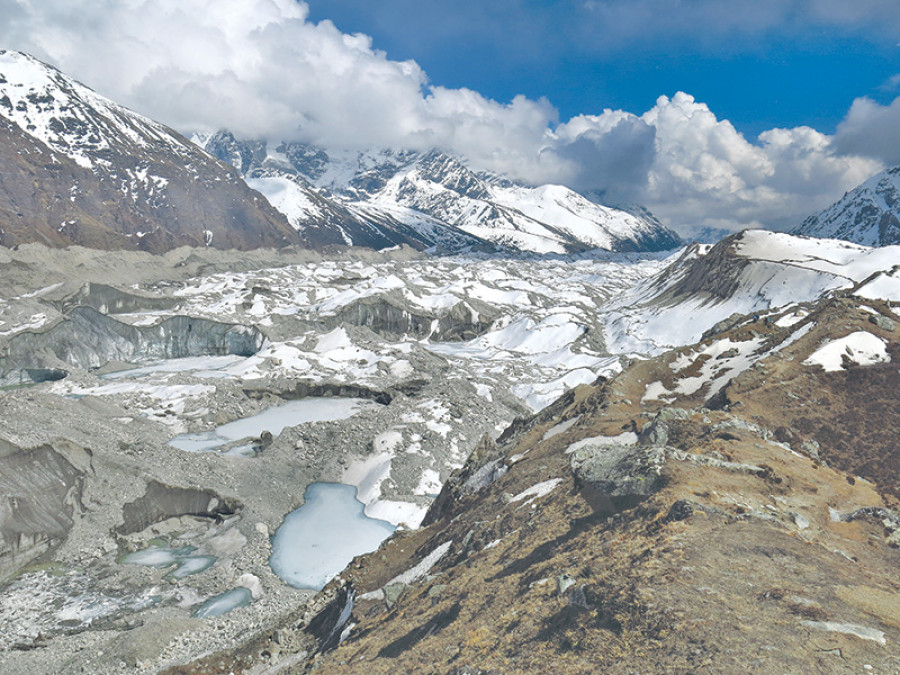Opinion
Walking on thin ice
More than one-third of the Himalayan glaciers will melt due to rising temperatures
Tsewang Nuru Sherpa
The Himalaya mountains will lose more than one-third of their ice by the end of the century, says a report entitled ‘Hindu Kush Himalaya Assessment: Climate Change, Sustainability, and Hope’, collated by the International Centre for Integrated Mountain Development. If the targeted climate goals are not achieved, and the rate of greenhouse gas emission continues, the report adds that the Himalaya could lose two-thirds of its glaciers.
While global media seems to only be fixated on the loss of ice sheets in the Antarctic and the Arctic, the recent assessment highlighting the shocking vulnerability of mountains in Asia. The report summarises how the Himalaya will have to go through the catastrophic process of meltdown if immediate action is not taken.
The range of glaciers in the Hindu Kush Himalayan Region spans over 3,200 km of Asia. The region is the birthplace of 10 major river basins and is home to almost 240 million people. Around 1.6 billion people living downstream rely heavily on these water resources for daily sustenance.
Therefore, the Hindu Kush Himalaya Assessment report highlights the significance of mountain resources and emphasises the measures that have to be taken to preserve the resources.
The disappearance of Himalayan glaciers signals potentially disastrous consequences, that will be negatively reflected on river flows, pollution and management of natural hazards. Countries like Nepal, that houses most of the mountain glaciers, will have to bear the negative consequences of a meltdown, as the ramifications presented by an increment in atmospheric temperature can have a direct effect on the melting of glaciers in Nepal.
One of the major concerns is the increasing volume of water in the glacier-fed rivers that can further escalate into glacial lake bursts when the rise in water volumes exceeds its capacity. This can exacerbate the already imposing water crisis problem, taking away the lives of millions of people living downstream. In addition, the loss of freshwater reserves is also evident, and leads to a long-term reduction in the amount of water flowing in the rivers. The existing plan and policies of Nepal have not yet taken the culminating threat of climate change, nor have we started systemically assessing changes in local temperatures.
The Hindu Kush Himalaya Assessment report is a great start to analysing the situation of increasing climate risk, and the conclusion drawn from it only adds to the amount of work that is mandatory for curbing and combating climate change risks. If this trend continues, the ice on the Himalaya will disappear; and in the long run, all the rivers in Nepal will go dry, inviting a serious water crisis for drinking, irrigation and other concomitant purposes. The more we delay taking action, the higher will be the cost and chances of facing catastrophic repercussions.
Mitigation actions implemented now can reduce the intensification of future warming while slowing down climate change effects on ecosystems. The 1.5 degrees Celsius target set by the Intergovernmental Panel on Climate Change in Paris is a good start, but the questions remains whether global commitment is ready, especially among high-emission nations.
Nepal, as one of the major mountainous nations, has a very low or marginal contribution to greenhouse gas emissions in comparison to some of the developed nations in the world. Yet, the ecosystem in the mountains and the people are vulnerable to climate change, and there is inadequate information about adaptation and mitigation. Therefore, a need to develop adaptation strategies with approaches for more vulnerable areas in our region is obligatory.
While the retreat of glacial lakes can be taken as a spectacular indicator of global climate change, the underlying focus also needs to be on livelihoods, ecosystem services, and the environment.
A deeper understanding of how climate change is taking place in the mountainous region of Nepal has to be understood, and the potential impact rendered on social and ecological systems needs to be laid down. There is little data about the mountain areas of Nepal, despite being climate change hotspots. Thus, the need to collaborate with communities, local practitioners and government bodies to develop solutions through information sharing is extremely critical.
Sherpa is a WWF Nepal scholar.




 16.2°C Kathmandu
16.2°C Kathmandu












